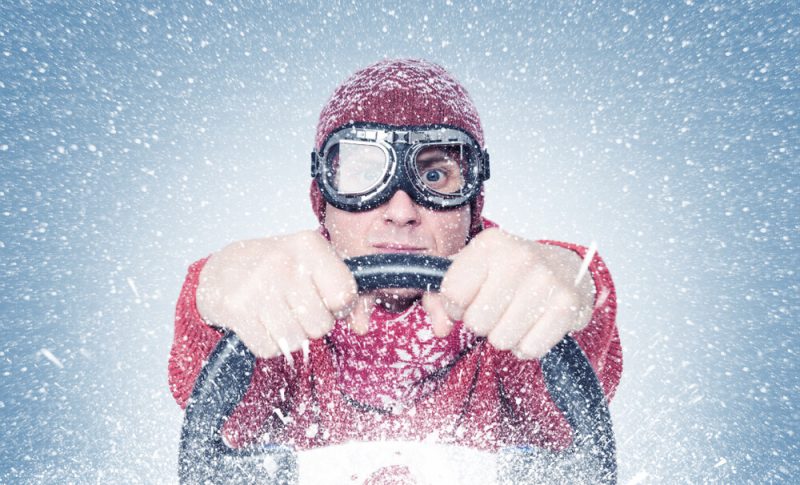Blog
When Your Car Turns into an Ice Cube: Winter Auto Insurance Tips in Washington

Picture this: You step outside, your car looks like a popsicle, and your driveway has the same friction coefficient as a curling rink. Welcome to winter in Washington. Grab a scraper, a (frosty) sense of humor, and these winter Washington auto insurance tips so you can skid less and save more. Otherwise, you might find yourself skidding straight into a Sasquatch!
Why Winter Weather Can Freeze Your Coverage
Cold snaps don’t change what your policy covers, but winter exposes coverage gaps you might not notice in July. Here are the essential three to understand:
- Liability pays for the other driver’s injuries and property damage when you’re at fault. It does not fix your car but helps cover accident-related costs in winter.
- Collision pays for your car’s repairs after a crash, including those winter slide-into-a-stop-sign moments.
- Comprehensive covers non-crash damage, including falling ice, broken glass from a heavy snow slide, theft while you’re warming the car, or a branch that decides your hood is a chaise lounge.
There are a few other things to potentially consider, because you don’t want to be stuck with the bare minimum car insurance (it’s just like wearing flip flops in a snowstorm). The prominent VIPs for frosty weather include UM/UIM (uninsured/underinsured motorist) in case you get into a snow-surfer situation with someone who has no insurance, and personal injury protection (aka MedPay), which helps with medical bills regardless of fault. That’s handy when black ice proves you are, in fact, not a professional figure skater.
Common Winter Claims in Washington
Washington drivers face a mix of mountains, passes, and rain that turns sneaky when temps drop. Frequent cold-season claims include single-vehicle collisions (think losing traction on black ice), rear-end accidents in slushy, stop-and-go situations, glass claims from rapid temperature changes and falling ice, as well as storm damage, fallen branches, and even car theft, unfortunately.
How Ice and Snow Affect Your Premiums
There’s no mystical icy road coverage surcharge that appears on your bill. But accidents and claims affect rates. A winter crash filed under collision can nudge your premium upward at renewal, especially if the company surcharges at-fault losses. Good news: Preventing even one claim (hello, snow tires and patience) often saves more than any seasonal “discount” ever could.
Preparing Your Car for Winter Accidents
You can’t negotiate with physics, but you can prepare for it. Think “fewer surprises, faster recoveries.” Here are the things to do to get ready for a snowy PNW winter.
Essential Winter Safety Equipment
The following pieces of winter safety equipment can make all the difference during the season. They’re also helpful in a pinch during an emergency. Here’s what to keep in mind:
- Winter or all-weather tires: They grip better in cold temps than summer or worn all-season tires. Better traction = fewer oopsies.
- Tire chains: Required on some Washington mountain routes when posted. Keep a set that fits your tire size.
- Inflated spare, jack, and lug wrench: To avoid the “I have three wheels and a dream” situation.
- Ice scraper and brush: An old rewards card is not a scraper. Your paint will testify.
- Jumper cables or a jump pack: Batteries hate cold. You will love a jump pack at 6 a.m.
- Reflective triangles, flashlight, gloves, and blanket: For comfort and visibility if you do end up stuck.
- Shovel and traction aid: Cat litter, sand, or traction mats help you escape compact snow berms.
- Windshield washer fluid rated for freezing temps: Blue stuff is your friend. Water is not.
How Snow Tires Impact Insurance Rates
People often ask about snow tire insurance savings. In most of the U.S., carriers typically don’t offer a specific “snow tire” discount like you might see in Canada. But installing proper winter tires can reduce your crash risk, help you qualify for safe-driver discounts, and potentially keep your telematics score happier if you’re on a usage-based insurance policy. Bottom line: You may not get a direct line-item discount, but winter tires can indirectly keep your premiums saner by preventing claims.

Snowy Morning Driving Guide: What to Do Before You Get Going
This handy checklist is a must-have when you have a snowy morning drive ahead of you. Here’s the exact steps to take when you’re heading out (maybe run through it mentally while your vehicle is heating up — they all matter when it comes to winter car safety):
- Check conditions. For Washington winter driving, look at pass reports and local advisories. If chains are required, “hoping not” is not a plan.
- Clear the car completely. Roof, hood, lights, cameras, and sensors. Snow flying off your roof is a mobile blizzard for the car behind you.
- Warm up wisely. Don’t leave your car unlocked and idling. “Warm-up theft” is real, and while comprehensive usually covers theft, avoiding the claim is better.
- Set your following distance to “grandma level.” More space, slow inputs, gentle braking. ABS and stability control help, but they aren’t magic.
- Disable cruise control on slick roads. Cruise was not designed for surprise skating rinks.
- Know your route’s escape options. If traffic stops on a hill, you’ll want room to avoid becoming a human curling stone.
Discounts and Coverage Options for Cold Months
Winter is a great time to ask your agent to audit your policy. You’re not locking in seasonal coverage forever; you’re choosing the right protection for the risk you face. Check for these things:
- Collision and comprehensive: If you carry both, you’re set for most winter mishaps. If you dropped collision on an older car, ask what that means if you slide into a pole.
- Glass coverage: Some policies or endorsements lower the deductible for windshield repair versus replacement. Tiny chips become big cracks in freezing weather (and it’s also helpful for protecting your car from angry squirrels).
- Rental reimbursement: If your car needs repairs after a covered claim, this keeps you mobile while the shop plays “defrost and fix.”
- Telematics/usage-based programs: If you drive less in winter or you’re a smooth operator, you might earn a discount. Results vary by carrier.
Roadside Assistance Benefits
Roadside assistance for Washington drivers can include towing to the nearest shop after an issue happens, winching if you’re stuck in snow within a short distance from the highway, and jump starts and fuel deliveries if needed. Of course, all your other standard options are included too, like lockout help and flat tire service. Roadside is not accident insurance, but it turns a miserable day into a manageable one.
Temporary Winter Coverage
“Can I buy temporary winter coverage just for a road trip?” True short-term auto policies are rare in the U.S., but you can often add or adjust endorsements mid-term, raise or lower deductibles at renewal, and potentially have a storage-only option if you’re storing a summer car. Talk to an agent before you leave for the passes, so changes are active when you need them.
Keep Your Ride Protected This Winter: Get a Quote
Bundle your gear, warm your cocoa, and let an agent check your policy for winter-specific gaps. Whether you commute through sleet or plan a snow-chasing road trip, we can help tailor car insurance in Washington that fits your budget and risk. Get in touch with us today at Vern Fonk via phone at (800) 455-8276, at one of our many offices in your neck of the woods, or get a quote online today!
FAQs
Do I Need Snow Tires in Washington?
If you regularly drive in cold temps, mountain passes, or on untreated roads, winter or all-weather tires are a strong yes. They’re not legally required statewide, but chains may be required on posted routes. Snow tires don’t usually unlock a specific “snow tires insurance” discount, but they reduce crash risk, which helps your long-term premiums.
Will My Insurance Cover Accidents on Icy Roads?
There’s no special icy road coverage (despite what your Uncle Joe told you, it’s just an insurance myth), but collision typically covers your car’s damage when you slide and hit something. Liability covers others if you’re at fault. Comprehensive covers things like falling ice or storm debris. You can also get UM/UIM and PIP/MedPay help with gaps and medical bills.
How Can I Prepare My Car for Snow and Ice Without Breaking the Bank?
Prioritize tires with good winter traction, fresh wiper blades, proper washer fluid, an ice scraper, a shovel, and a small emergency kit. Many of these items are inexpensive and can prevent bigger costs. Check deductibles and consider adding roadside rather than paying à la carte for tows.
Can I Add Temporary Coverage for Winter Travel?
True short-term policies are uncommon. Instead, ask your agent to add roadside assistance, confirm rental reimbursement, and review deductibles before your trip. You might also temporarily increase certain limits if you’re planning long mountain drives, then reassess later.
What Should I Do if My Car Gets Stuck in Snow?
Stay visible, clear snow from the exhaust, and avoid spinning tires endlessly. Use a shovel and traction aids. If you can’t safely free the vehicle, access roadside assistance in Washington from your insurer. Many policies include winching from a short distance off the roadway.


